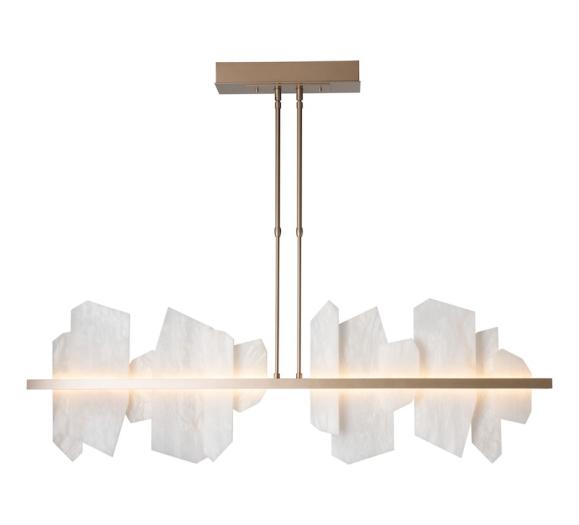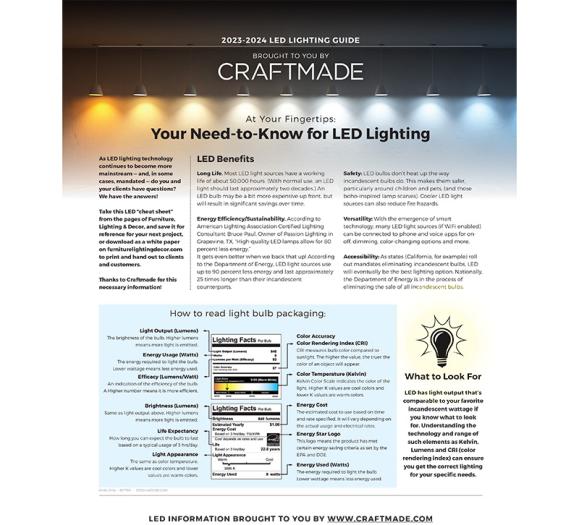This article was originally published in March 2017 on the Residential Lighting website. Residential Lighting was the precursor to Furniture, Lighting & Decor. The magazine ran for 25 years and was a go-to source in the lighting industry for news, product introductions and design trends.
For more lighting tips and design advice, check out Randall Whitehead's blog here. Randall is our resident Lighting Doctor, and his advice is straightforward, practical and always a little humorous.
Residential Lighting: What is the difference between line and low voltage?
Meeker: Line voltage means that it’s running on the line voltage of the home without a transformer, which is 120 volts. It’s table lamps, and most ceiling fixtures, chandeliers, are line voltage. Low voltage means there’s a transmitter, and [the electricity is] being transformed so the 120 volts is being brought down to 12 volts. Some chandeliers are low voltage. A lot of recessed cans are low voltage. Task lighting, desk lights are low voltage sometimes.
RL: What are the advantages and disadvantages of each?
Meeker: Typically the advantage of line voltage is that it’s going to be a less expensive fixture because you don’t have a transformer. It tends to be sort of more traditional lighting style fixtures.
Low light voltage, on the other hand, uses smaller light bulbs, so you can have more compact fixtures. There’s a type of lamp called an MR16, which is used in recessed cans, and the great thing about MR16s is they make incredible variety of beam spreads. So if you want to have a really super narrow spot or if you wanted to have a big, wide flood, they’ve got that and everything in between. So, the advantage of low light voltage is that it’s got a lot more interesting lamps to use than with line voltage.
With line voltage, [if you want] recessed cans, usually you have either a flood or a spot; there’s a choice between the two, and that’s about it. Whereas with the low voltage lighting, there might be 20 different beam variations in any given wattage. And the other advantage for recessed cans is that there are different types of lenses that can be put in front of low voltage lighting — some line voltage lamps have that but more usually in the low voltage field — so you can change the way the light is. So not only do you have all these beam spreads, but you also have these effects you can create: You can soften the beam, you can stretch it out, you can do all sorts of things with it. So it’s great for lighting artwork, for creating mood and accent, that sort of thing.
RL: Is there one that’s becoming more popular these days?
Meeker: Well… the lighting industry is kind of thrown up in the air right now. And that’s because there’s a lot of legislation going through right now to eliminate tungsten light bulbs, which is a line-voltage light bulb. Australia, right now, I don’t know if they’ve done it yet, but they’re going to eliminate the standard old light bulb because it’s not very energy efficient. It creates a lot of heat for the amount of light it produces. So for energy reasons they’re getting rid of it. MR16s, halogens, was kind of the ruling light source, and what’s going on now is low voltage LED is now sort of usurping its position… The LEDs are very expensive [2018 Editor's Note: This isn't the case anymore], and they haven’t completely filled out all the different categories that are being done by the low-voltage light bulbs right now. I think it’s just a matter of time before that occurs. LEDs are a light-emitting diode. It’s a type of lamp that they used initially on electronic equipment and they started using it for signal lights, like when you have a controlled intersection, when you have an automobile traffic. The advantage of them is their life is astounding… [A] line-voltage standard light bulb has about a 700- to 1,000-hour life. The low-voltage light bulb has between a 2,000- and 3,000-hour life. The LED [has about a] 10,000- to 100,000-hour life. They also use very little electricity. The disadvantage, though, is that right now [LEDs are] really expensive, but if they go into higher production, the price will come down. They are low voltage. You have to have a special [device] — it’s called a driver, which is a kind of transformer that powers them.
RL: What are some other disadvantages to low-voltage light fixtures?
Meeker: One of the disadvantages of the low-voltage light bulb [is] that you need to have a transformer somewhere. And sometimes transformers buzz and hum. You don’t normally get a buzz or hum from a line-voltage light bulb.
RL: Is there anything that retailers can suggest to consumers to buy to reduce that sound?
Meeker: Well, buy good quality fixtures, number one. Number two, when you are installing low-voltage light fixtures, you have to have a low-voltage dimmer to go with it. That sometimes helps reduce the noise. And then proper installation also helps. If you follow those three guidelines — good equipment to start with, the proper dimmer and then also the right installation — you should have a problem. But, you know, it does come up every once in a while, so it’s a matter of sort of fiddling around with some of the components to see if you can get it to quiet down.
RL: In terms of energy usage, which is better?
Meeker: [Low-voltage is not a whole lot more energy efficient than line-voltage]. It turns out that tungsten, as we said, is not very energy efficient; it generates a lot of heat. Next up on the ladder of electricity usage is halogen… [which] is more efficient with its wattage, so it produces more light per watt, about one-and-a-half times the amount. The next up on the ladder would be fluorescent. And fluorescent in a sense is low-voltage because it has a ballast with it. It’s more energy efficient. One of the disadvantages of fluorescent is you can’t really focus the beam very well; it’s more of a general illumination. It can be dimmed, but you have to use special dimmers and ballast to do it. And then on the top of efficiency heap would be LEDs.
RL: In terms of installing a transformer, is that something a homeowner can do themselves?
Meeker: Well, usually. Let’s say you buy a chandelier that has little low-voltage light bulbs on it. The transformer is usually inside the canopy that attaches to the ceiling. So it’s not as if it’s some sort of special box that you have to deal with. It’s part of the fixture. But the designer had to create room when they designed the fixture to put the transformer somewhere. So it’s usually a half-sphere that’s on the ceiling. Whereas with a line-voltage they don’t have to deal with that issue because there is no transformer. And it tends to be a little flatter or not a half-dome. It’s usually not a big obstacle; it’s just part of the fixture, and you just install it as you would any other sort of fixture.
For more information on what's going on in energy efficiency and smart home adoption today, check out our Year of the Smart Home series. The third part will be published in the September 2018 issue of Furniture, Lighting & Decor.
- Part 1
- Part 2







